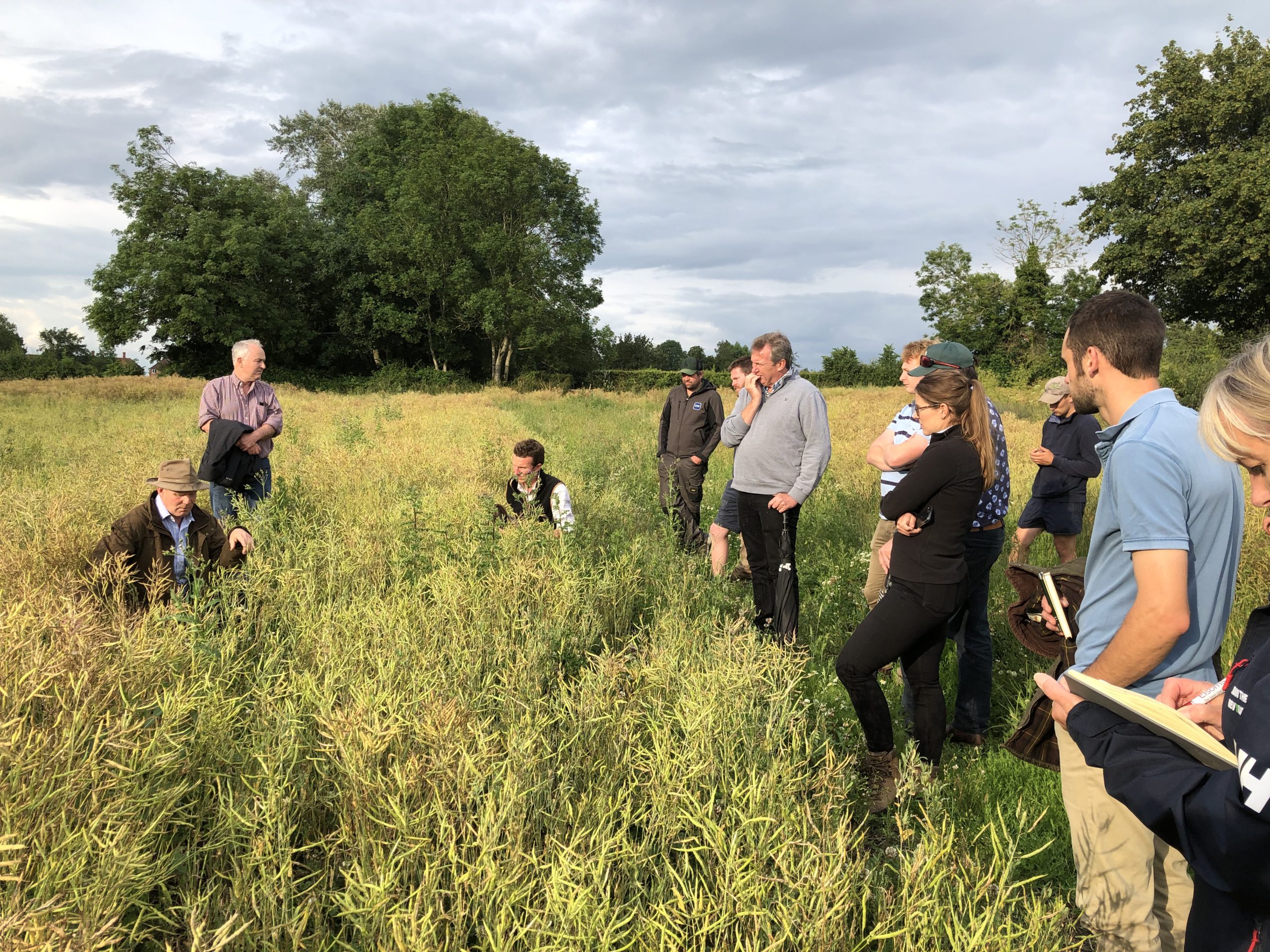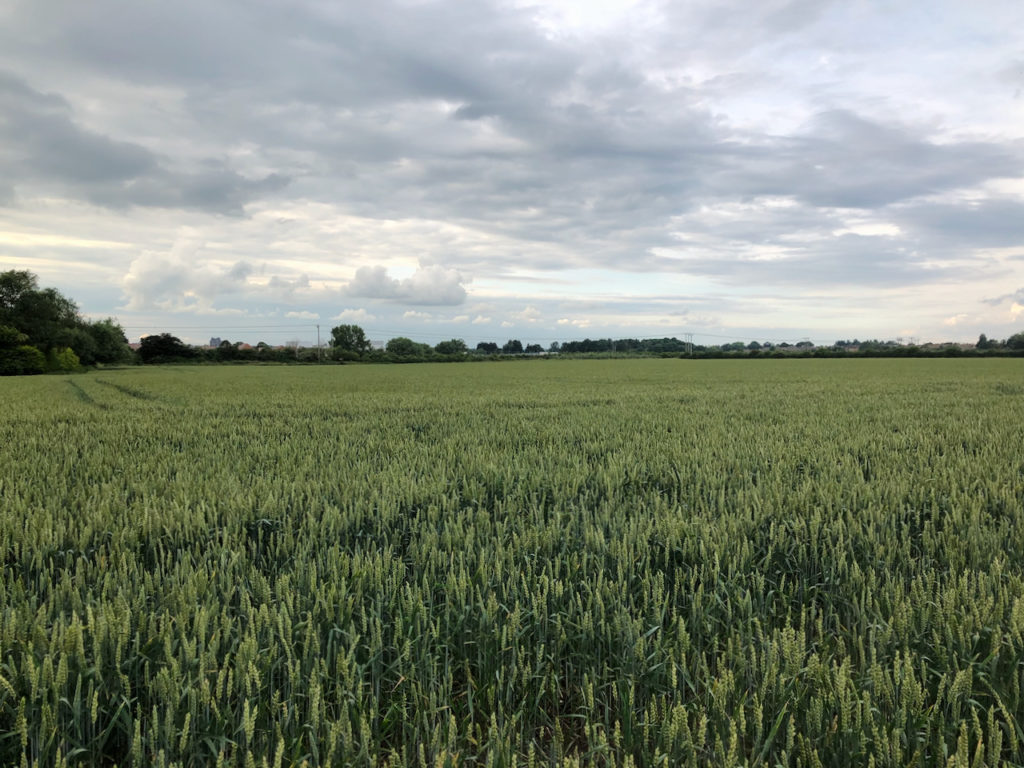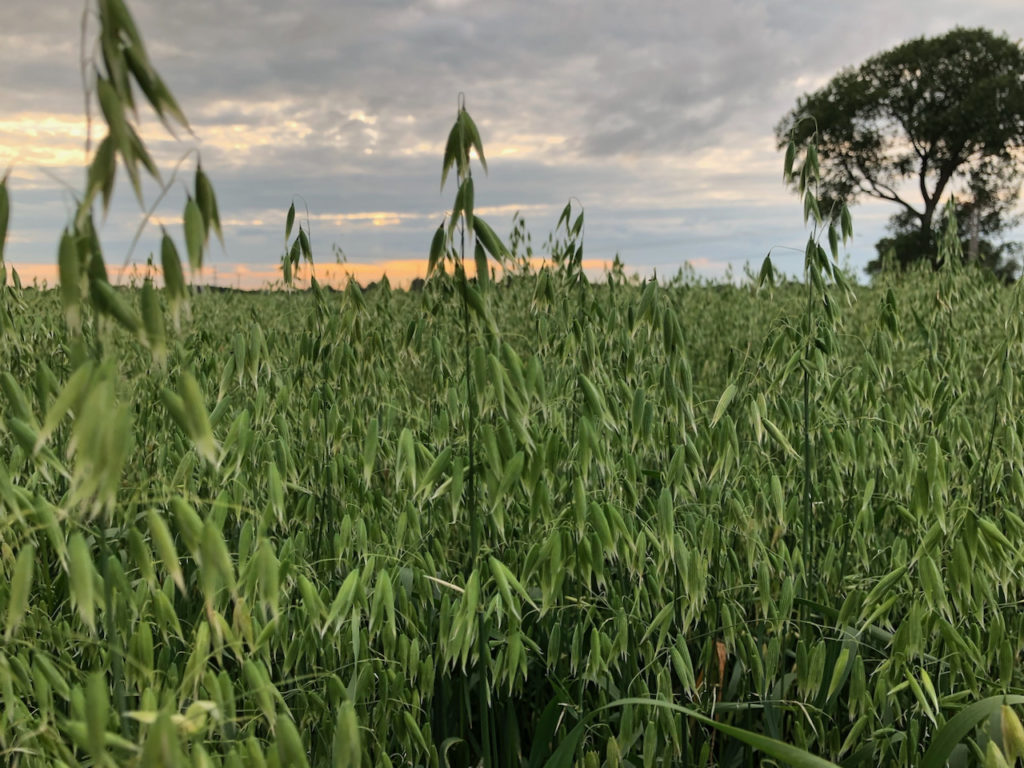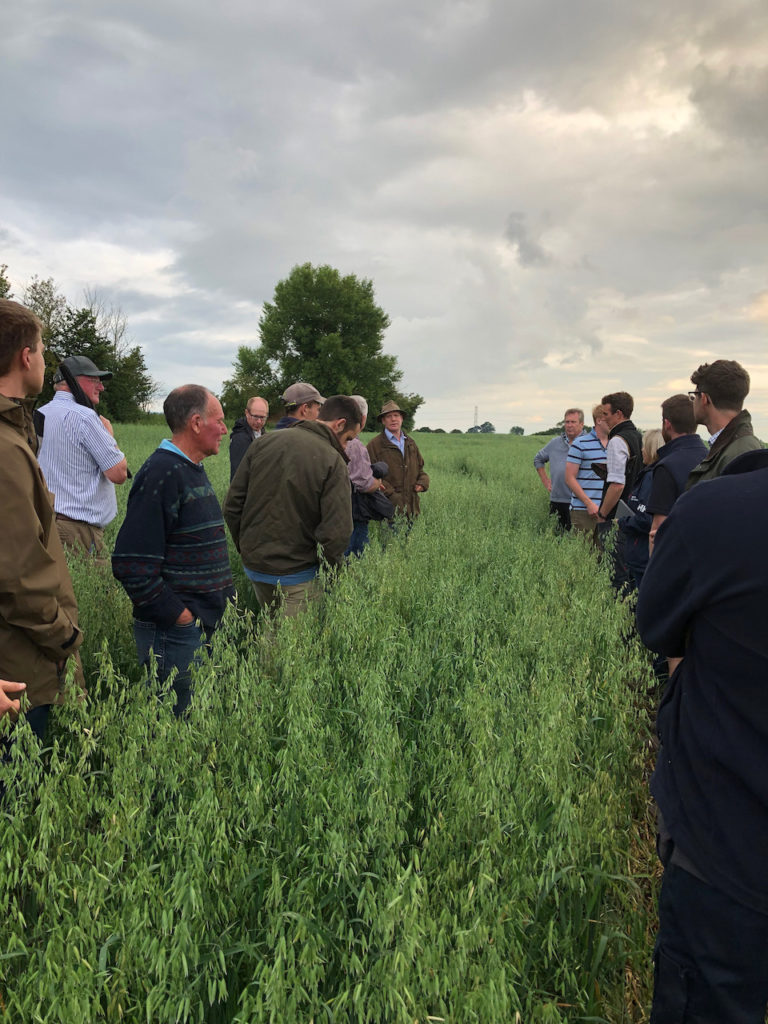
On a muggy evening, and in a COVID compliant way, a group of farmers gathered in Buckinghamshire to hear more about why Antony Pearce was awarded runner up in this year’s Soil Farmer of the Year competition.

Antony started the evening giving an introduction to his journey into regenerative agriculture, explaining that his first inspiration was from reading David Montgomery’s book. It was this book that helped to transition from a ‘safe and conventional system’ to a place where he was focused on advanced soil health. This provided a lot of food for thought and alternative ways of thinking about some of our traditional management practices. A key example of his questioning, he explained to the farmer attendees came from the nutrient availability and soil pH graph, that depicts the amount of a nutrient that is available depending on the soil’s pH.
“It just seemed counter intuitive,” Antony explained, “how could a plant growing in a soil of pH7 never manage to access sufficient quantities of iron?”. He went onto share his experiences of attending Elaine Ingham’s soil health course which allowed him to satisfy his previous dissatisfaction. Through learning undertaken within the course, he started to understand the importance of the plant root zone and the ability of plants to create the right environment around the root zone for accessing nutrients, through microbial activity.
“Plants are able to secrete 30-40% of their energy through their roots to feed the bacteria and fungi in the soil, which is why I started to get concerned about the impact of fungicides. If we are relying on the soil fungi to feed the plants, what negative impact are the fungicides having to this relationship?”

As such, Antony started on a quest to remove fungicides from his crop protection programme, instead investigating the use of genetics and varietal choice to ensure that his crops has the best chance to ward off disease pressure. This started with a reduction in applications and now no fungicide is applied on the 150ha of the farm which is managed in a regenerative manner. However he wasn’t planning on stopping there, the next aspiration was to drastically reduce (and eventually eliminate) Nitrogen fertiliser). Again he credits this decision to learning from the soil food web course – explaining that the application of Nitrogen requires a carbon source for the microbes, and the most readily available carbon source is the liquid carbon being pumped out of the root exudates. He has started dramatically reducing the amount of Nitrogen that he is applying.
Antony has split the farm in half and manages 150ha of it in a regenerative, low input manner and 150 ha of it conventionally. This provides the opportunity for him to analyse the financial performance of each systems and also see whether there are visual differences in weed pressures, yields and soil health. Initially he was relying on organic manures to provide some nutrients, however it is proving an expensive method of importing nutrients and organic matter; as such, he is looking to move away from organic manures to including more cover crops.
“My original reason for looking at low input system was after some conversations that were showing the yields that organic farmers expect. My 10 year average from the conventional system is 9.1t. Comparing the numbers, I was spending £130 per tonne for every additional tonne over organic yields. This seemed like something to focus my attention on.”
At this point we left the barn and started to head towards some crops to see the philosophies in action!

The first field that we stopped in was a field of oilseed rape. Immediately the discussions turned to the amount of Nitrogen that had been applied. This field has had no soil applied bagged Nitrogen; it has received 30kg of Nitrogen from digestate and 15kg applied through a foliar application at flowering. The field has also had no fungicides or insecticides. Antony explained that last year he had grown some zero nitrogen wheat which had yielded 6.5t. Discussions soon moved onto blackgrass control, as there were some plants visible in the rape crop. The field has an understorey of clover that was blown into the standing rape crop. Antony shared some thoughts about whether clover was a useful control measure for blackgrass as in his experience “they don’t seem to get on very well together.” The clover covers the gaps and provides ground cover and weed suppression, and that is the main reason for it. He explains, “whether it helps my rape yield is immaterial, I don’t want a carpet of blackgrass!”

Antony is planning on utilising more cover crop and spring cropping options through stewardship, as such, is not massively worried about current blackgrass levels, as he feels there are options that allow his to deal with it. His clover understory was blown into the previous wheat crop in April, and when the wheat was harvested, the clover went from something that looked a bit poorly established to a thick mat of cover. In July a rape / fenugreek mix was blown into the standing wheat before it was combined.
“Weeds wise we vary across the farm, but I seem to find there is a direct relationship between soil health and the length of time since the field has been in grass. The longer it has been out of grass the less vigorous the seeds establish.”
The soil type across the farm is heavy clay. As Antony has transitioned to this farming system, he confesses to being ‘less scared of his land than he used to be’. He is also starting to see results, with last year being the first year that he didn’t find a crack across the farm. The heavy clay soils bring their own challenges, in terms of being able to get on the land and trafficability. He has been improving his soil in the past with the use of compost and is positive about the benefits that compost brings, not just in terms of organic matter, but also in terms of available nitrogen over the longer term. He has worked out that if he regularly applies compost over 5 years, then the following wheat crop will be able to access 200kg of Nitrogen, which provides an interesting experiment to see whether it persists to become available. Compost is made ideally from a 50 / 50 mix from woodchip (Antony runs a free tip service for local tree surgeons) and cow manure.
Ideally all the straw from the farm is chopped and returned, but occasionally there is a swap for some manure with a neighbouring beef farmer.
Being heavy land, (and still including rape in the rotation) the discussion inevitably moved onto slug control and the measures that were in place on the farm. Antony stubble rakes after the rape has been drilled potentially up to 5 times, starting at cotyledon stage. He admits that it is a challenge, which is exacerbated by his desire to get a cover crop in. “It’s a balancing act,” he explains, “ if you need to go for slug control, you need to rake, rake, rake, but you then forego your ability to have a cover crop. Sometimes we manage to get cover through the rape volunteers, and it fulfils the function at the same time.”
Another aspiration for Antony is to start to be able to hold water across the farm. When he was visiting Gabe Brown in America a lasting memory was discussions about holding more water and providing cover – which gives the rain time to percolate into the soil. He has found a similar experience on his farm, “back in the winter we had a big crop of mustard, and there was a big rainfall event (around 100ml), the field walked beautifully – it managed to hold onto the water and soak into the soil.”
One of the other benefits of the transition has been the ability for the rotation to be more flexible. “Originally the risk factors for me to start to adopt spring cropping was the potential for a spring drought,” Antony explains, “if we can now start to develop a system where we can effectively capture water over the winter through the use of a cover crop which lets the rain work its way into the soil, then I don’t need to worry about spring droughts as the water reserves are there.” The ultimate aim is to transition 100% of the farm onto this system.

After the rape field, we crossed the road to go and visit some wheat which has been managed conventionally. The wheat was spring sown and drilled on the 15th March, and was used as a comparison. Across the farm, the aim is always to have a conventional versus low input to be able to scrutinise the results, and look at the costs. The reasoning behind the comparison, is so that Antony can assess the regenerative practices from a cost benefit perspective. The ultimate aspect of success is if these practices are then undertaken on the conventional land. The field had a mustard cover crop that was spun on with a fertiliser spinner which was then grazed with sheep in early winter before the crop was drilled. The ability to conduct such large scale trials is brilliant in terms of the ability to provide the direct comparison across half the farm. Antony is doing it to show other people what is possible and what isn’t, and he documents his journey through his You Tube channel where he is keen to not just show the successes but also the times where it doesn’t go so well.

The benefits of livestock were then discussed and whether the benefits could be seen immediately. The wheat field had 1000 sheep on it over the winter that were moved regularly, and Antony was keen to point out that on the heavier land, there was a need to leave a rest period between the sheep leaving the field and drilling the subsequent crop.
“I had a go with a range of options this year from drilling straight behind the sheep, to leaving it up to 2 months, and where the land was left, the crop came better. Without a doubt we need to leave at least a month between the sheep coming out and us drilling. The soil needs time to recover, the worms need to come up to grab the muck and reintroduce the air into the soil.”
In the field that we were looking at, the sheep had come out on the 20th December and the wheat had been drilled in mid March. “We want the sheep to hit it hard and then move on,” Antony explains, “which sometimes can take some explaning. Its worked quite well and I worked together with the shepherd to explain what we wanted and to come up with a system which benefited everyone, and meant as few logistical challenges as possible. We try and design it so the sheep are hitting the mustard stands earlier in the season and then move onto the vetches later.”

The final fields to look at were a comparison of two fields of oats, The first field has been in long term arable, and was direct drilled. It was visibly different compared to the following field which had been in arable for 3 years after grass. The oats are the Elianne variety and are grown on a gluten free contract for human consumption. Again the oats are managed using a low input system and had only had 15kg of foliar N. They had been stubble raked to liberate some Nitrogen.
Antony is experimenting with different Nitrogen products to see what the best format is for his system, and explains how he ensures that there is a control strip so that a direct comparison can always be made. He then summed up the importance of trialling things out.

“There is a need to provide the evidence as to what works on your farm.”
This epitomises the system that Antony has developed; not just the visual differences in the crops, but the numbers to back it up and an ability to try new things and continue to innovate.
On the walk back to the farmyard, there was an opportunity to see some of the farm’s other diversification projects to ensure future resilience, including turkeys, sloe gin, and the creation of dog arenas.
A fantastic and thought provoking walk which provided lots of new ideas. Thank you so much to Antony for a brilliant evening. To follow Antony’s progress make sure to subscribe to his YouTube channel here.

